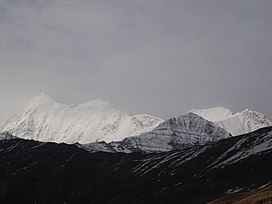Trisul
Mountain in Uttarakhand, india From Wikipedia, the free encyclopedia
Mountain in Uttarakhand, india From Wikipedia, the free encyclopedia
{Use Indian English|date=July 2015}}
| Trishul | |
|---|---|
 Trishul from Bedini Bugyal | |
| Highest point | |
| Elevation | 7,120 m (23,360 ft)[1][2] |
| Prominence | 1,616 m (5,302 ft)[3] |
| Listing | Ultra |
| Coordinates | 30°18′46″N 79°46′38″E[1] |
| Geography | |
| Location | Bageshwar, Uttarakhand, India |
| Parent range | Kumaun Himalaya |
| Climbing | |
| First ascent | 12 June 1907 by Tom Longstaff, A. Brocherel, H. Brocherel, Karbir[4] |
| Easiest route | Northeast flank/north ridge: snow/glacier climb |
Trisul is a group of three Himalayan mountain peaks of western Kumaun, Uttarakhand, with the highest (Trisul I) reaching 7120m. The three peaks resemble a trident - in Sanskrit, Trishula, trident, is the weapon of Shiva. The Trishul group forms the southwest corner of the ring of peaks enclosing the Nanda Devi Sanctuary, about 15 kilometres (9 mi) west-southwest of Nanda Devi itself. The main peak, Trisul I, was the first peak over 7,000 m (22,970 ft) to have ever been climbed, in 1907.
The three peaks are named Trisul I, Trisul II, and Trisul III. The massif is a north-south ridge, with Trisul I at the north end and Trisul III at the south. The massif runs roughly North-South, and hence appears compressed when viewed from the south (Ranikhet, Kausani), and more stretched out from the Southeast (Chamoli, Bedini Bugyal).
Nanda Ghunti lies a few Kilometres to the northwest, while Mrigthuni is just to the southeast.
| Mountain | Height (m) | Height (ft) | Coordinates | Prominence (m) | First ascent |
|---|---|---|---|---|---|
| Trisul I | 7,120 | 23,359 | 30°18′46″N 79°46′38″E | 1616 | 1907 |
| Trisul II | 6,690[5] | 21,949 | 30°17′24″N 79°46′12″E[6] | <200[7] | 1960 |
| Trisul III | 6,007 | 19,708 | 30°15′00″N 79°46′12″E | <200[7] | 1960 |
T. G. Longstaff made the first climbing reconnaissance of Trisul, in September 1905, focussing on the western and southern sides.[8] He returned in 1907 with Charles Granville Bruce, Arnold L. Mumm; the three Alpine guides Moritz Inderbinnen and the brothers Henri and Alexis Brocherel; and a number of Gurkhas, including Karbir Burathoki. They ascended through the Rishiganga valley, to the north of the peak, onto the Trisul Glacier, which lies on the east side. From there they climbed the northeast flank to the north ridge, reaching the summit on 12 June.[9] At the time Trisul was probably the highest mountain to have been climbed.[10] The climb was noted also for the first use of supplementary oxygen in a major climb.[11] During the 1950s Harold Williams led Indian Army expeditions to the summit.[citation needed]
Routes on the west face and south ridge of Trisul I have also been climbed. The south side was first ascended in 1976 by a Yugoslavian expedition, with Slovenian climbers Andrej Graseli and Štefan Marenče reaching the peak on 15 May, followed by Vanja Matijevec the following day.[12] There was a notable ski expedition to Trisul by Indian Institute of Skiing and Mountaineering, Gulmarg with Lt Col N. Kumar as the leader.
Trisul II and Trisul III were first climbed in 1960 by the Yugoslav team JAHO I. They climbed from the Bidalgwar glacier, achieving the summit of Trisul II via the southern ridge and Trisul III via the north ridge.[13]
Another Yugoslav expedition made the first traverse of the three peaks in 1987, and two members paraglided from the summit.[14]
The Trisul massif can be accessed via the following route: Almora - Kausani - Garur- Gwaldam - Debal - Bagargad - Wan - Bedini Bugyal - Kalu Vinayak - Roopkund - Trisul.
Seamless Wikipedia browsing. On steroids.
Every time you click a link to Wikipedia, Wiktionary or Wikiquote in your browser's search results, it will show the modern Wikiwand interface.
Wikiwand extension is a five stars, simple, with minimum permission required to keep your browsing private, safe and transparent.